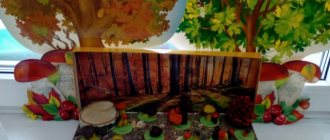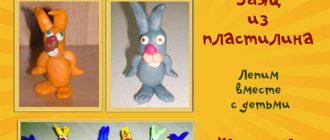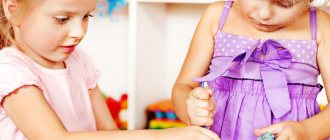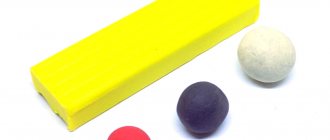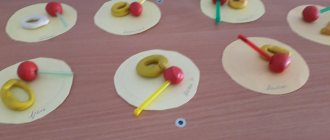Modeling techniques for the composition “Cockerel with his family”
According to the Federal State Educational Standard, the topics of modeling lessons are repeated annually, but differ in the level of complexity of techniques for making crafts. Children 6–7 years old:
- develop the skill of turning “sausages” into flagella, for example, to show the feathers on the tail of a rooster;
Children of the preparatory group learn to convey the plot in the poses and movements of the figures
- improve the skill of forming “peas” from “balls” for the eyes of birds;
- practice the skill of smoothing seams when pinching parts, for example, a neck with a head and torso;
- learn to pull back plasticine to get pointed elements, for example, a rooster's beak;
- reinforce the skill of creating identical parts in shape and size, for example, bird wings;
- choose the colors of plasticine for the figures themselves;
Using certain shades of plasticine, children should rely on a familiar image: fairy-tale or real
- They use stacks to give the elements of the craft a relief.
Kitten with a heart
On Valentine's Day, you can give not only valentines, but also original crafts. We recommend that you make a kitten from plasticine step by step according to the photo instructions provided.
Sculpting technique:
- From a blue base, mold a body in the shape of a heart, a tail, and ears.
- Connect these parts and stick stripes of a lighter shade on top, creating a “cat” color.
- Make the muzzle, eyes and nose as shown in the photo.
- Detail the animal's face using a stack.
- All that remains is to attach the paws, the heart is made from a red base.
- The holiday craft is completely ready.
What types of modeling are suitable for the theme “Cockerel with his family”
To embody the theme, plot modeling is used. However, other types are also involved in the work.
Subject modeling
Combining birds sculpted using object technique into a common mise-en-scène makes it possible to develop entire scenes where the figures are presented not only statically, but also dynamically, that is, with wings spread for flight, with a bowed head, an outstretched neck, etc.
For plots, children sculpt figures with heads turned and wings in different positions.
Object modeling
Children convey the image of a rooster, hen and chicks as accurately as possible, focusing on the picture or their own ideas about the bird. Then the individual figures are combined into an overall composition. In this type of modeling, children actively use stacks and sticks to add texture to the wings, that is, they make the image realistic.
Object modeling involves the creation of individual figures, which are then combined into an overall composition, that is, a plot
Decorative modeling, that is, the creation and decoration of crafts based on folk crafts, is connected to the theme “Cockerel with his family” if the figurine of the “head of the chicken family” is stylized as a Filimonovsky or Dymkovo cockerel.
Decorative modeling in the preparatory group involves painting clay bases, that is, a very labor-intensive process, so this type of modeling is usually practiced in circle classes
Plasticineography
Elements of a plasticine drawing on the theme “Cockerel and his family” are used, as a rule, to decorate the background for the mise-en-scène, which is prepared in advance, for example, during the children’s independent activities on the eve of class. Or they represent a separate type of fine art - plasticineography.
In compositions for modeling, plasticineography is used to design the base.
Modeling techniques
The theme “Cockerel and his family” is realized using five modeling techniques.
Sculptural (plastic)
The figurine is created from one piece of plasticine by stretching, smoothing or pinching elements. Children 6–7 years old practice precision manipulation with plasticine, trying to make the details as naturalistic as possible: a pointed beak, a thin crest, an elongated neck that smoothly turns into a body, claws on the paws, etc.
Sculptural modeling in the preparatory group is complicated by the active use of stacks to add texture to the image
Constructive modeling
This technique consists of combining finished parts into a single composition. So, to create a chicken, children separately form an oval-shaped body, a round head, an elongated ball turning into a cone for the beak, “sausages” of legs, elongated “pancakes” for the wings, and a rounded shape for the tail.
Particular emphasis is placed on the accuracy of smoothing and smearing of elements.
In constructive modeling, all the details are first prepared, and then a solid figure is assembled from them.
Combined technique
The combination of sculptural and constructive modeling is called a combined technique. For example, using a sculptural method, a torso is made from one piece of oval-shaped plasticine and the neck and head are extended from it. And the wings, paws, tail, comb and beard are attached from separately sculpted elements made using constructive techniques.
In a combined technique, children usually sculpt their torso and head.
Modular technology
Modeling is based on combinations of modules - separately sculpted figures, representing 2-3 independent plots, which are complemented by details and combined into a single composition. For example, a cockerel, a hen, a chick in the framework of crafts on the theme “Poultry” are supplemented with grass, a house, and an appropriate description and the craft “Cockerel with his family” is obtained.
In this composition, the modules are cockerels, which were combined into one plot: birds peck grain
Modeling according to shape
Waste material is used in the sculpting of bird figurines, for example, toy cases in Kinder Surprise, which are covered with plasticine and supplemented with separately sculpted wings, tail and beak. This technique produces funny yellow chickens.
The shape of chickens is familiar to children from the middle group; in preparatory crafts they are complicated by the use of additional materials - ready-made eyes, which need to be carefully and symmetrically glued on
Creating the Foundation
Thin cardboard serves as a backing for the composition “Cockerel with Family”. If it is assumed that not only birds, but also other elements will be placed on the base: a fence, a lawn with grass, a well, etc., then the base must be made in advance. Usually, children are allocated time for independent activity after nap time for this work. Preschool children cover the substrate with plasticine, sculpt details of the surroundings - a fence, a house, etc. - and choose a suitable place for them on the base.
Hedgehog
A small forest animal with thorns will end up right on your table. Even a small child can make a cute rodent. Modeling from plasticine for children is incredibly exciting fun.
How to make:
- Prepare the materials necessary for work. Make a small ball from a brown base.
- Now you need to stretch the resulting workpiece a little; the ball should turn into a drop-shaped figure.
- Next, we sculpt a nose and eyes for the hedgehog from plasticine with the children. Attach everything to the body.
- You will need to place the seeds on the surface of the sculpted figure with the pointed part facing up. Attach the “needles” in the same way as shown in the photo.
- When the empty spaces on the body of the forest animal are filled with seeds, place the plasticine figurine on the cardboard. All is ready!
Materials for modeling
The leading material for creating the “Cockerel with Family” craft is plasticine; clay and salt dough can also be used. In this case, the modeling can be supplemented with origami details. For example, the cockerel and hen are made of plasticine, and the chickens are made of yellow paper. Another option for decorating crafts is adding natural materials. Thus, the tail feathers can be made from natural bird feathers.
Natural feathers for decorating the tail can be pre-painted with paints
Modeling tools
When organizing a workspace for modeling, you need to ensure the availability of:
- frames - sticks of different lengths/thicknesses (or toothpicks) for fastening parts or supporting structures;
- stacks (pointed and rounded);
- special board or mats for work.
Features of modeling in the preparatory group
Types of sculpting:
- subject - a generalized image of the characteristic features of individual objects (duck, owl, crow, etc.);
- plot - a composition of several objects and objects, an artistic embodiment of episodes from fairy tales, literary works (K. Ushinsky “Cockerel with his Family”) or scenes from the surrounding life (“Cockerel with a Hen”, “Hen with Chicks”), practiced only in the older and preparatory groups;
- decorative - a plastic embodiment of the image of a cockerel and a hen in the style of traditional techniques of folk decorative art according to a sketch independently prepared by the child using bright, rich painting (geometric or plant patterns), for example the Filimonovskaya toy, or additional materials (beads, feathers, buttons, shells, seeds ) as an original decoration of the product.
Examples of plot compositions on the theme “Cockerel with his family”
"Cockerel with his family on a walk"
“Cockerel and Hen” modeling in the tradition of the Filimonovskaya toy
"Filimonov family"
"Chicken in a cozy nest"
“Easter chicken” made from salt dough
"Naughty cockerels"
Much attention is paid to collective modeling, thanks to which children develop the skills of coordination of actions, teamwork, improve the psycho-emotional qualities of solidarity, and demonstrate feelings of camaraderie and responsibility. When performing a collective composition, the teacher divides the children into subgroups of four to five people and gives them different tasks, for example, one group sculpts cockerels, another - hens, a third - chickens, a fourth - invents and makes decorations.
Examples of collective work
Examples of various tasks on the topic “Cockerel with his family”
"The chicken went out for a walk"
"Filimonovskie cockerels"
"The Cockerel Family"
Technical types of modeling:
- Constructive - with this method, an image is created by combining and connecting different parts or parts as elements of a constructor. A child masters this technique at the age of two or three, inventing a model and its components.
- Sculptural - modeling from a single piece of material, the child kneads and gives the necessary shape, fashioning an image from a shapeless piece, using a whole arsenal of auxiliary small finger movements: stretches the shape of a beak or tail, crushes it to form wings, twists, pinches, conveying the texture of the surface, presses and etc.
- Combined - a large form is sculpted in a sculptural way, for example, the body, and parts and details (wings, tail, beak, eyes) are attached separately using the molding method. In older preschool age, children prefer this particular option for creating products.
- Modeling using a ready-made form - a thin cake of rolled material is wrapped around a durable form (jar, bottle), the excess is removed, and the seams are smoothed. If necessary, carefully remove the frame form. In this topic, this method is most often used to form the body of a cockerel or chickens.
- Modular modeling - a product is created by constructing from ready-made identical elements (modules), for example, balls, flagella, plates, according to the principle of a volumetric mosaic.
Equipment and tools:
- frames (sticks of different lengths and thicknesses), which are used as load-bearing rods or fasteners for parts or parts of a figure;
- stacks - pointed, rounded, as well as in the form of a spatula and a loop of sticks, used to remove excess clay, make cuts for paws or wings and work out details and texture (feathers, eyes, beak) using drawing and strokes;
- special boards, the size of which depends on the size of the figure (for a figure of 15x20 cm, a board of 22x35 cm is suitable) or rotary machines.
Special boards are usually used for modeling
Characteristic features of modeling work for older preschoolers:
- The desire to more accurately convey the shape of an object, to complement it with secondary details (decorative decorations, external interior or scenery for a plot composition), to depict it in motion.
- Independent selection of an episode, implementation of work planning.
- A wide range of techniques and materials used (clay, plasticine, dough).
- The works of children of senior preschool age embody a generalized image that conveys the vivid characteristics of an object without deep specification and elaboration of details.
Basic skills and knowledge acquired by six-year-old children at previous stages and options for their further development:
- Ability to distinguish and sculpt the shapes of a ball, cylinder, cone and disk.
- In the preparatory group, children are taught to convey the ratio of quantities (more or less), compare similar objects, create compositions (“Mischievous cockerels”, “Chicken in a cozy nest”, “Chickens for a walk”) from painted clay or colored plasticine and place them on stand.
- Use of the tape method of attaching a tape-shaped base to a base, techniques of pressing and pulling, pinching, mastered in the senior group, studying the method of circular molding. These fine hand techniques are especially in demand in the decorative sculpting process.
- Modeling of birds, animals, toys in the style of folk crafts, for example, a Dymkovo toy, from a single piece by drawing out individual parts or parts; later, children are shown options for sculpting individual parts of a bird figure (head and body from a cone or cylinder, flat modeling of wings) and their connections.
Children with interest not only sculpt a folk toy, but also decorate it with original ornaments.
Options for implementing the topic in the educational process
According to the calendar and thematic plan of the educational direction “Artistic and Aesthetic Development”, modeling classes are supposed to be once every two weeks. The theme “Cockerel with his family” is usually implemented as part of a modeling lesson in the fall or spring, based on personal impressions from a holiday in the village or the story of the same name by K. Ushinsky studied in younger groups.
At the same time, the creation of crafts can be correlated with the topics of other educational courses. For example, acquaintance with folk crafts in classes on familiarization with the environment is realized in January by sculpting a Filimonovsky cockerel, and in the spring, using the same technology, children can sculpt a cockerel with its family as part of a craft project.
Modeling can be a reinforcement of topics for various educational courses
Summary of educational activities for modeling in an early age group for Mother's Day
Summary of educational activities for modeling with young children 2-3 years old.
Direct educational activity with young children on the topic: “Candy, a gift for mom” Description of the material : I offer a summary of direct educational activity on modeling for children of the first junior group (2-3 years). This material will be useful for teachers of younger groups. Integration of educational areas : artistic and aesthetic development, cognitive development, speech development. Goal : “Make a candy out of plasticine” Objectives : Educational
: improve the ability to work with plasticine, consolidate the ability to twist a sausage out of it, teach how to twist a candy from this sausage (the shape of a “snail”)
Developmental
: develop children’s auditory attention, memory, attention, thinking .
Educational
: to cultivate affection, care, reverent relationships with each other, to cultivate a desire to take care of mother, to help her.
Equipment : pieces of plasticine placed in separate plates, boards for plasticine, cotton swabs (after removing the cotton wool from them) Preliminary work : Watching the cartoon “Mom for a Baby Mammoth”, conversation on the topic “My Beloved Mommy”
Progress of the lesson:
Mom means tenderness, This is affection, kindness, Mom means serenity, This is joy, beauty! Mom is a bedtime story, This is the morning dawn, Mom is a hint in difficult times, This is wisdom and advice! Mom is the greenery of summer, This is snow, an autumn leaf, Mom is a ray of light, Mom means LIFE! Guys, do you want to give mom a gift? What does your mother like? Probably something tasty? And sweets? Do you like lollipops? I think your mother also really loves these candies, but she treats you to them all the time, but she doesn’t get any. In honor of such a holiday as Mother's Day, let's prepare lollipops for our mothers? To do this, you and I will take plasticine and remember it well in our palms. Then we’ll put it on the board and start twisting the sausage with our palms (showing all the discussed actions). Then roll the sausage between your palms. As a result, we got a long sausage made of plasticine. Now we wrap one end inward and continue to twist it further, making a sort of “snail”. When we have twisted the “Snail”, we put it on a stick. And what did I do guys? That's right, a lollipop. Now guys, try to make these sweets yourself. Children begin to work independently with plasticine. The rolling technique may not be easy for children, so if the child is unable to roll a sausage of the required size, the teacher takes the child’s hands in his own and helps the child. Look guys, what kind of candy they turned out to be! Your mothers will be very pleased!
We recommend watching:
Integrated lesson with children of the first group of early age Synopsis of educational activities in the 1st junior group on familiarization with the outside world. Visiting a fairy tale Technological map for organizing joint activities with children of the 2nd early group Synopsis of educational activities in the early age group with presentation
Similar articles:
Lesson notes for the 1st junior group of kindergarten. Introduction to clay
Lesson summary for an early age group. Getting to know the sun
Summary of a game development lesson in kindergarten in the second group of early age on the topic: Animals
Summary of a game lesson for children of the third year of life on the topic: Octopus
Summary of a game lesson for children of the third year of life on the topic: Clocks
Forms of organization and individual approach
As for the form of organization of work, the theme “Cockerel with his family” can be implemented as an individual or collective craft. In the first case, children prepare the substrate in advance and sculpt birds during the lesson. In the second case, the teacher divides the children into subgroups of 4-5 people and, depending on their proficiency in modeling skills, and also taking into account the wishes of the children, distributes the “front of work”: one subgroup is engaged in sculpting roosters, the second - chickens, the third sculpts chickens, and the fourth is in the process of coming up with designs for the backing. At the same time, children try to make birds in different poses.
Usually in the first and fourth subgroups there are guys who show a special interest in modeling. They can also be given the task of choosing additional material to decorate the craft or compose a story based on the composition.
Collective modeling implies the distribution of responsibilities in the preparation of the substrate: drawings, modeling from natural materials, etc.
One of the forms of implementing an individual approach is to practice modeling techniques. For example, rolling a pencil between the palms to practice the speed of movements of the palms and fingers when forming plasticine parts. And also a good training would be the creation of “flagella,” “pancakes,” and other elements that would correspond to the samples made by the teacher.
Modeling can be an option for organizing independent activities for children who show interest in this type of visual activity.
How to motivate children
The productivity of preschoolers depends on the quality of motivation, which is implemented by a number of techniques at the introductory stage of the lesson.
Table: motivational techniques for modeling classes on the theme “Cockerel with his family” in the preparatory group
| Reception and features of its use | Example |
| Pictures and posters that allow you to most accurately and proportionally convey the shapes of bird body parts. | |
| Conversation | The teacher invites the children to remember what kind of poultry they saw in the village or zoo, what their habits were observed, how the hen takes care of the chickens, what she teaches them, etc. |
| Poems, riddles that allow children to remember the main features of domestic birds (external, lifestyle). |
|
| Cartoon based on the story by K. Ushinsky “Cockerel with his family” for inventing the plot of the composition | Since Ushinsky’s story is studied in the second junior group, in the preparatory group the children repeat the plot and come up with situations where Cockerel could still reconcile all members of his family. For example, when all the chickens began to offend one, the smallest one. |
| Surprise moments for uniting guys in a common cause | Cockerel comes to visit the children and tells how he went for a walk with his family to the pond, but was so enchanted by his reflection in the water that he fell behind the hen and her chicks. And now he asks the children to help him return home by sculpting the composition “Cockerel with his family.” |
| Games |
|
To find differences you need to select bright and memorable images
Video: cartoon based on the story by K. Ushinsky “Cockerel with his family”
Drawing up notes for a sculpting lesson “Cockerel with his family”
The modeling lesson includes three stages of working on the topic:
- introductory, motivating children to work - up to 5 minutes;
- the main one, which includes determining the scheme for completing the craft, the modeling itself, physical education and/or finger gymnastics - up to 20 minutes;
- final, that is, the assessment of the children’s activities by the teacher and reflection - up to 5 minutes.
The purpose of the lesson is specified by the type and technique of creating the craft, for example, creating a plot composition using a constructive technique based on the content of the story by K. Ushinsky “Cockerel with his family.”
The formulation of the tasks implies techniques that will be practiced in the lesson:
- teach children to create, through collective efforts, a simple scene from sculpted figures;
- achieve greater accuracy in conveying the basic shape and characteristic details;
- develop the ability to collectively think about the placement of birds on a stand.
Table: Churakova O.A. Summary of the lesson on collective modeling “Cockerel with his family” based on the story by K. D. Ushinsky in the preparatory group
| Stage | Content |
| Introductory | Educator: - Guys, look at the pictures. Who is depicted there? Children: - Hen, chickens, rooster Educator: - Yes, let's remember what story we recently read, where these heroes are present? Children: - Cockerel with his family Educator: - Well done. Let's remember in more detail what happened in this story by watching the cartoon. (watching a cartoon, talking) Educator: - The chickens ran away, and the rooster and hen went to look for them. Come on, we, too, will go with the cockerel. |
| Basic | Physical education (In accordance with the text, children take steps in place, holding their hands behind their backs. Then they make circular movements with their hands, squat, shake their fingers, bend forward). |
| Children sit down. Teacher: - Guys, we have already been divided into groups, let’s remember who will sculpt what and start sculpting. Children with a teacher look at a model sculpted by the teacher. The teacher pays attention to the color and shape: the body is a big ball, the head is a small ball, the beak (small, sharp). | |
| Educator: - I take a small piece of plasticine and what do I do? I roll out the ball. This will be the chicken's head. Then I take a large piece of plasticine and also roll out the ball. This will be the body of the bird. Now we fasten the two balls by pressing them against each other. And now we make a beak, pinch it with two fingers. | |
| Finger gymnastics: Our cockerel suddenly woke up and turned straight to the sun. Crowed once, twice, three times! Don't oversleep today. | |
| Doing work by children. Individual assistance for children. | |
| Final | Placing finished works on a stand, examining and evaluating children's works. |
| Quote from: https://www.maam.ru/detskijsad/konspekt-nod-lepka-petushok-s-semei-po-raskazu-kd-ushinskogo-kolektivnaja-kompozicija.html | |
MAGAZINE Preschooler.RF
"I and my family". Integration of educational areas: cognition, communication, artistic creativity, reading fiction, health. Program content. Strengthen children’s ideas about family, family relationships, and the responsibilities of family members. Develop children's connected speech. Cultivate a sense of affection for your family members, love and a caring attitude towards your family members. Create a desire to talk about the relationship between children and adults in the family, to share your thoughts and feelings about your family. Equipment. Microphone, family photos. Preliminary work. Compiling stories about yourself and your family, looking at family albums, drawing portraits of family members, memorizing poems about mother and grandmother. Contents GCD - Guys, let’s imagine that we were all invited to the children’s program “Me and My Family.” Do you agree to be participants in this program? And who will I be? And I will be a TV presenter. Are the program participants ready? - Good afternoon! Today in our studio are children from the Olenyonok kindergarten in the city of Michurinsk. They came to our program to talk about themselves, about their family, about their dear and close people. At the beginning of our program, I invite you to introduce yourself and tell us a little about yourself. (Children's stories about themselves). - Guys, today we will talk about family. Tell me, what is family? (Children's answers). – What kind of families are there? (Children's answers). Families can be small and large, friendly and hospitable, happy and cheerful, hardworking. – Tell us, what is your family like, how many people are there, what do you like to do together? (Children's answers). - Guys, tell me, who is the dearest person in the world to you? (Children's answers). – That’s right, there is no one in the whole world dearer than mother. I suggest you say beautiful words to your mother. (Sweet, beloved, beautiful, gentle, affectionate, kind, beloved, pretty, charming, attentive, friendly, wonderful, wonderful, wonderful). Well, now, let's tell you about your mother. Children's stories. Natasha prepared a poem about her mother. Let's listen to him. Poem "That's what mom is like." Blagina. - Yes, guys, we need different mothers, all kinds of mothers are important. Everyone needs their mother: a child, a kitten, and a chick. Let's play with you the game "Cub and his mother." – Guys, which other members of your family could you tell about? (Children talk about their dad.) – Guys, you told us about your moms and dads. Who else lives with you? (Children's answers). – Who wants to tell us about their grandparents? - Now let's play the game “Name it kindly.” - Guys, is family just mom, dad, grandparents? (Answers). Of course not. These are only adult family members. And then there are the little family members. Who are they? (Children's answers). Who will tell me about their brother and sister? (Children's stories). – The time of our transmission has come to an end. Today we talked about your wonderful families. We listened to your stories about your family and friends. And now I want to remind you of the proverbs: * When the sun is warm, when mother is good. * Mother's affection knows no end. * The bird is happy about spring, and the baby is happy about its mother. Who are these proverbs about? * The hut is fun for children. * The whole family is together, and the soul is in place. – How many of you know proverbs about family? (Children name several proverbs). * Summary of the lesson. * Complete the trailers and add your family members to them. Sign the names.| Next > |


